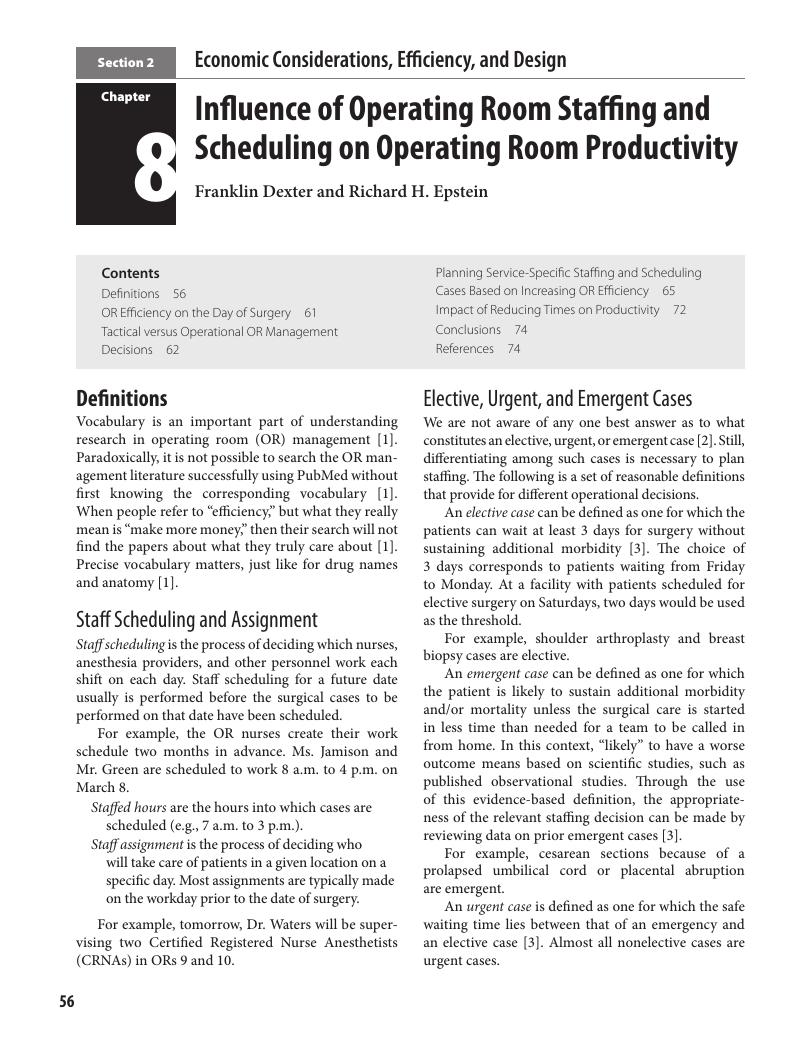Book contents
- Operating Room Leadership and Perioperative Practice Management
- Operating Room Leadership and Perioperative Practice Management
- Copyright page
- Dedication
- Contents
- Contributors
- Foreword 1
- Foreword 2
- Preface to the Second Edition
- Section 1 Leadership and Strategy
- Section 2 Economic Considerations, Efficiency, and Design
- 7 Flow Disruptions in Surgery
- 8 Influence of Operating Room Staffing and Scheduling on Operating Room Productivity
- 9 Operations Management and Financial Performance
- 10 Reengineering Operating Room Function
- 11 Operating Room Design and Construction
- 12 Operating an Ambulatory Surgery Center as a Successful Business
- 13 Influence of Patient- and Procedure-Specific Factors on Operating Room Efficiency and Decision Making
- 14 Operating Room Management in the Perioperative Surgical Home and Other Future Care Models
- 15 Non-Operating Room Locations
- 16 Efficiency and Scheduling
- 17 Operating Room Budgets
- Section 3 Surgical and Anesthesia Practice Management
- Section 4 Nursing
- Section 5 Safety, Standards, and Information Technology
- Index
- References
8 - Influence of Operating Room Staffing and Scheduling on Operating Room Productivity
from Section 2 - Economic Considerations, Efficiency, and Design
Published online by Cambridge University Press: 16 November 2018
- Operating Room Leadership and Perioperative Practice Management
- Operating Room Leadership and Perioperative Practice Management
- Copyright page
- Dedication
- Contents
- Contributors
- Foreword 1
- Foreword 2
- Preface to the Second Edition
- Section 1 Leadership and Strategy
- Section 2 Economic Considerations, Efficiency, and Design
- 7 Flow Disruptions in Surgery
- 8 Influence of Operating Room Staffing and Scheduling on Operating Room Productivity
- 9 Operations Management and Financial Performance
- 10 Reengineering Operating Room Function
- 11 Operating Room Design and Construction
- 12 Operating an Ambulatory Surgery Center as a Successful Business
- 13 Influence of Patient- and Procedure-Specific Factors on Operating Room Efficiency and Decision Making
- 14 Operating Room Management in the Perioperative Surgical Home and Other Future Care Models
- 15 Non-Operating Room Locations
- 16 Efficiency and Scheduling
- 17 Operating Room Budgets
- Section 3 Surgical and Anesthesia Practice Management
- Section 4 Nursing
- Section 5 Safety, Standards, and Information Technology
- Index
- References
Summary

Information
- Type
- Chapter
- Information
- Publisher: Cambridge University PressPrint publication year: 2018
